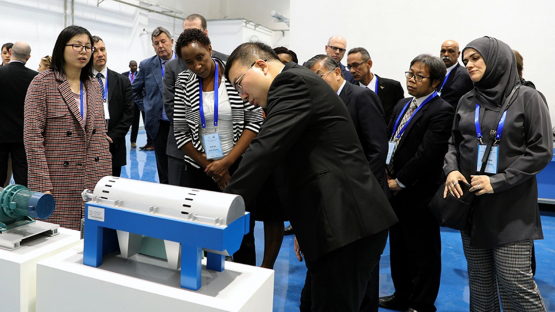
Nuclear security professionals learn about equipment in use at China's State Nuclear Security Technology Center's integrated training facility for nuclear material accounting and control at the annual meeting of the Network of Nuclear Security Support Centres in March 2019. (Photo: State Nuclear Security Technology Center, China)
The International Network for Nuclear Security Training and Support Centres (NSSC Network), coordinated by the IAEA, plays a key role in international cooperation and the sharing of best practices in nuclear security. At the network’s annual meeting in Beijing this week participants discussed how they can increase their cooperation for strengthened protection of nuclear and other radioactive material against terrorism and smuggling.
The 85 participants from 48 countries shared experience on dealing withinsider threats – dangers posed by someone with legitimate access to a facility, such as an employee or a contractor. In addition, they discussed data analysis and the development of information management tools. They also planned technical exchange visits for the coming year.
“Our Member States have asked us to play a central role in strengthening the nuclear security framework globally,” said Raja Abdul Aziz Raja Adnan, Director of the IAEA’s Division of Nuclear Security, at the annual meeting. “In that respect, the IAEA coordinates and implements activities through which countries can cooperate to minimize the risk of nuclear and other radioactive material being used in a malicious way.”
Mr Raja Adnan spoke of the close cooperation between the IAEA and nuclear security authorities and other stakeholders worldwide, particularly in the area of training. In 2018 alone, 2200 participants from 139 States took part in 105 IAEA nuclear security training courses and workshops – many of which were organized at various NSSCs, building on their expertise.
“The NSSC Network and the IAEA can now provide more customized support and expand into a wider range of technical activities, in a structured, systematic, and sustainable manner, to meet the needs of individual centres,” Mr Raja Adnan said. “We must always aim for continuous improvement to stay ahead of the threat while endeavoring to use limited resources efficiently.”
Sharing global resources through international cooperation
An example of the efficient use of global resources is cooperation in training activities and the international use of facilities, such as China’s State Nuclear Security Technology Center, an NSSC member and this year’s host. Of the 3000 participants trained at the training centre since its opening in 2016, 700 came from outside China, said Deputy Director General Zhenhua Xu. “Nuclear security is the responsibility of every single individual in the nuclear sector – training is therefore a central element for strengthening nuclear security capacity,” he said.
The facilities at the centre, located on an 8 hectare modern campus in suburban Beijing, include a nuclear material accounting and control training facility, a physical protection testing field equipped with barbed wires, video cameras, other intrusion detection devices and radiation monitoring gates and an emergency response simulation room. The centre also has an analytical laboratory, which provides analysis of nuclear material focusing on the quantification of uranium and or plutonium in samples to check whether any nuclear or other radioactive material may have gone missing. Another laboratory enables nuclear security practitioners to test whether nuclear security equipment can withstand extreme weather events and remain functional. A virtual shooting gallery and an area that is a mock nuclear facility allow security guards to train on how to fight terrorists inside a power plant. Elevated platforms enable trainers to monitor the training from above and provide instructions.
Meeting participants had an opportunity to use the facilities, including the so-called hold-up laboratory, which measures nuclear material in pipes. This is important to see whether the full nuclear material is accounted for. “If something is held up in the bend of a pipe, we know it is not stolen,” Mr Xu explained.
Preparedness and coordination are key to sustaining nuclear security, and the participants were able to see how China, which operates 42 nuclear reactors and has 13 more under construction, is approaching it, said James Conner, the IAEA nuclear security officer working with the NSSC network. “Countries with smaller nuclear programmes shouldn’t feel pressured to build facilities like this – with proper planning they can establish a centre more suited to their national needs while also taking advantage of what countries with major nuclear power programmes can offer,” he said. (From IAEA)

Representatives of nuclear security training centres from 48 countries came together to exchange experience and strengthen cooperation at their annual meeting in Beijing, China in March 2019. (Photo: State Nuclear Security Technology Center, China)